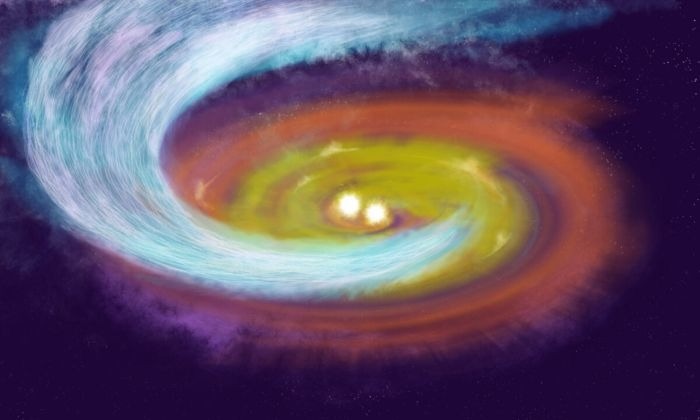A group of astronomers headed by Paulo Cortes, a scientist at the U.S. National Science Foundation’s National Radio Astronomy Observatory and the Joint ALMA Observatory, has made a groundbreaking discovery about how young star systems grow. The study was published in The Astrophysical Journal Letters.
 Artist's interpretation of a star-forming nursery shaped by magnetic fields. Image Credit: NSF/AUI/NSF NRAO/P. Vosteen
Artist's interpretation of a star-forming nursery shaped by magnetic fields. Image Credit: NSF/AUI/NSF NRAO/P. Vosteen
With the powerful Atacama Large Millimeter/submillimeter Array (ALMA), the researchers observed for the first time a narrow, spiral-shaped gas streamer guided by magnetic fields, channeling matter from a surrounding cloud in the Perseus star-forming region directly onto a newborn binary star system.
Stars form within clouds of gas and dust, but recent observations suggest that this process is far more dynamic than once believed. ALMA’s data captured both dust and molecular gas swirling around the newborn binary star system SVS13A, revealing that magnetic fields not only permeate these stellar nurseries but also actively guide the flow of material, directing gas onto the disk where new stars and planets take shape.
Imagine a garden hose, not carrying water, but smoothly delivering star-forming material along a winding path shaped by invisible forces. That’s the image revealed by ALMA’s observations: a stream of gas, called a “sub-Alfvénic streamer,” guided and regulated by spiral magnetic field lines.
This new data gives us a new window into star formation. This streamer shows how magnetic fields can regulate star formation by shaping the infall of material, like a dedicated highway for the cars to move along.
Paulo Cortes, Scientist, National Radio Astronomy Observatory, U.S. National Science Foundation
ALMA’s images and data reveal two spiral arms of dust encircling the stars, accompanied by a gas streamer that closely traces the same path. This striking alignment indicates that the gas moves more slowly than previously thought, supporting the idea of a magnetically guided channel rather than a turbulent, collapsing cloud.
The presence of this streamer, connecting the surrounding cloud to the disk and feeding material in a controlled manner, suggests that both gravity and magnetic fields play essential roles in the formation of stars and the planetary systems that may later emerge around them.
This groundbreaking discovery represents the first time astronomers have directly mapped both a gas streamer and its guiding magnetic field within a single observation.
Journal Reference:
Cortés, P. C., et al. (2025). First Results from ALPPS: A Sub-Alfvénic Streamer in SVS 13A. The Astrophysical Journal Letters. doi.org/10.3847/2041-8213/ae0c04.